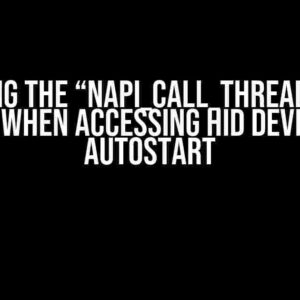Are you tired of struggling with Oracle Apex errors? Do you want to take your workflow process page to the next level? Look no further! In this comprehensive guide, we’ll dive into the world of raised user-defined exceptions and show you how to master the start-workflow process page like a pro. Buckle up, because we’re about to take your Oracle Apex skills to new heights!
What is a User-Defined Exception in Oracle Apex?
In Oracle Apex, a user-defined exception is a custom error message that can be raised when a specific condition is met. Think of it as a personalized warning sign that alerts the user to potential issues. By leveraging user-defined exceptions, you can create a more intuitive and user-friendly experience for your end-users.
Why Use User-Defined Exceptions in Oracle Apex?
- Improved Error Handling**: User-defined exceptions allow you to handle errors more elegantly, providing clear and concise error messages that users can understand.
- Enhanced User Experience**: By raising exceptions at specific points in your workflow, you can guide users through the process and prevent frustration.
- Better Debugging**: User-defined exceptions can help you identify and debug issues more efficiently, saving you time and effort.
Raising a User-Defined Exception in Oracle Apex
Raising a user-defined exception in Oracle Apex is a straightforward process. Here’s a step-by-step guide to get you started:
- Declare the Exception**: In your Oracle Apex application, navigate to the
Shared Componentssection and click onApplication Items. Create a newConstantwith a descriptive name, such asMY_EXCEPTION. - Define the Exception Message**: Create a new
Text Messagewith a clear and concise error message. For example:
declare l_message varchar2(4000); begin l_message := 'Invalid input detected. Please review and correct the data.'; raise_application_error(-20001, l_message); end;
Raising the Exception in a Workflow Process
Now that you’ve declared the exception, it’s time to raise it in your workflow process page. Let’s assume you have a process that checks for invalid input data:
declare
l_input_data varchar2(100);
begin
-- Validate input data
if :P1_INPUT_DATA is null or :P1_INPUT_DATA = '' then
raise_application_error(-20001, 'Invalid input detected. Please review and correct the data.');
end if;
-- Continue with the workflow process
...
end;
In this example, the exception is raised when the input data is null or empty. You can customize the condition to fit your specific requirements.
Handling the User-Defined Exception
When the exception is raised, Oracle Apex will display the custom error message to the user. But how do you handle the exception and provide a seamless user experience? Here are some tips:
Using the APEX_ERROR Package
The APEX_ERROR package provides a set of functions and procedures to handle and display error messages. You can use the APEX_ERROR.ADD_ERROR procedure to add the error message to the error stack:
declare
l_error_message varchar2(4000);
begin
l_error_message := 'Invalid input detected. Please review and correct the data.';
apex_error.add_error(
p_message => l_error_message,
p_display_location => apex_error.c_inline_in_notification
);
end;
Redirecting to an Error Page
Alternatively, you can redirect the user to a custom error page using the APEX_UTIL.REDIRECT_URL procedure:
declare
l_error_message varchar2(4000);
begin
l_error_message := 'Invalid input detected. Please review and correct the data.';
apex_util.redirect_url('f?p=&APP_ID.:ERROR_PAGE:&SESSION.');
end;
Best Practices for Handling User-Defined Exceptions
- Keep Error Messages Concise**: Ensure that your error messages are clear, concise, and easy to understand.
- Use APEX_ERROR Package**: Leverage the APEX_ERROR package to handle and display error messages consistently throughout your application.
- Test Thoroughly**: Test your user-defined exceptions extensively to ensure that they are raised correctly and handled elegantly.
Common Use Cases for User-Defined Exceptions in Oracle Apex
User-defined exceptions are versatile and can be applied to various scenarios in Oracle Apex. Here are some common use cases:
| Use Case | Description |
|---|---|
| Invalid Input Data | Raise an exception when input data is invalid or does not meet specific criteria. |
| Business Rule Validation | Raise an exception when business rules are violated, such as invalid dates or incompatible values. |
| Workflow Approval | Raise an exception when approval workflows are incomplete or require additional information. |
| Data Integrity | Raise an exception when data integrity is compromised, such as duplicate records or inconsistent data. |
Conclusion
Raised user-defined exceptions are a powerful tool in Oracle Apex, allowing you to create a more intuitive and user-friendly experience for your end-users. By following the steps outlined in this article, you can master the start-workflow process page and take your Oracle Apex skills to the next level. Remember to keep your error messages concise, test thoroughly, and leverage the APEX_ERROR package to handle exceptions elegantly. Happy coding!
Frequently Asked Question
Get ready to dive into the world of Oracle Apex and workflow processes!
What is the purpose of raising a user-defined exception in an Oracle Apex start-workflow process page?
Raising a user-defined exception in an Oracle Apex start-workflow process page allows you to handle and manage errors or unexpected conditions that may occur during the workflow process. This enables you to take corrective actions, notify stakeholders, or simply log the error for later analysis.
How do I raise a user-defined exception in an Oracle Apex start-workflow process page?
To raise a user-defined exception in an Oracle Apex start-workflow process page, you can use the RAISE_APPLICATION_ERROR procedure in your PL/SQL code. This procedure allows you to define a custom error message and error code, providing more flexibility and control over error handling.
What are the benefits of using user-defined exceptions in Oracle Apex start-workflow process pages?
Using user-defined exceptions in Oracle Apex start-workflow process pages provides several benefits, including improved error handling, increased flexibility, and better error reporting. It also enables you to create more robust and reliable workflows that can handle unexpected conditions and errors.
Can I use user-defined exceptions to stop a workflow process in Oracle Apex?
Yes, you can use user-defined exceptions to stop a workflow process in Oracle Apex. By raising an exception, you can halt the workflow process and prevent further actions from taking place. This is particularly useful when an error occurs and you need to prevent further processing to avoid data inconsistencies or other issues.
How do I handle user-defined exceptions in Oracle Apex start-workflow process pages?
To handle user-defined exceptions in Oracle Apex start-workflow process pages, you can use exception handlers in your PL/SQL code. These handlers allow you to catch and handle exceptions, providing a more robust and fault-tolerant workflow process. You can also use Oracle Apex’s built-in error handling mechanisms, such as error pages and error messages, to notify users and administrators of errors.






